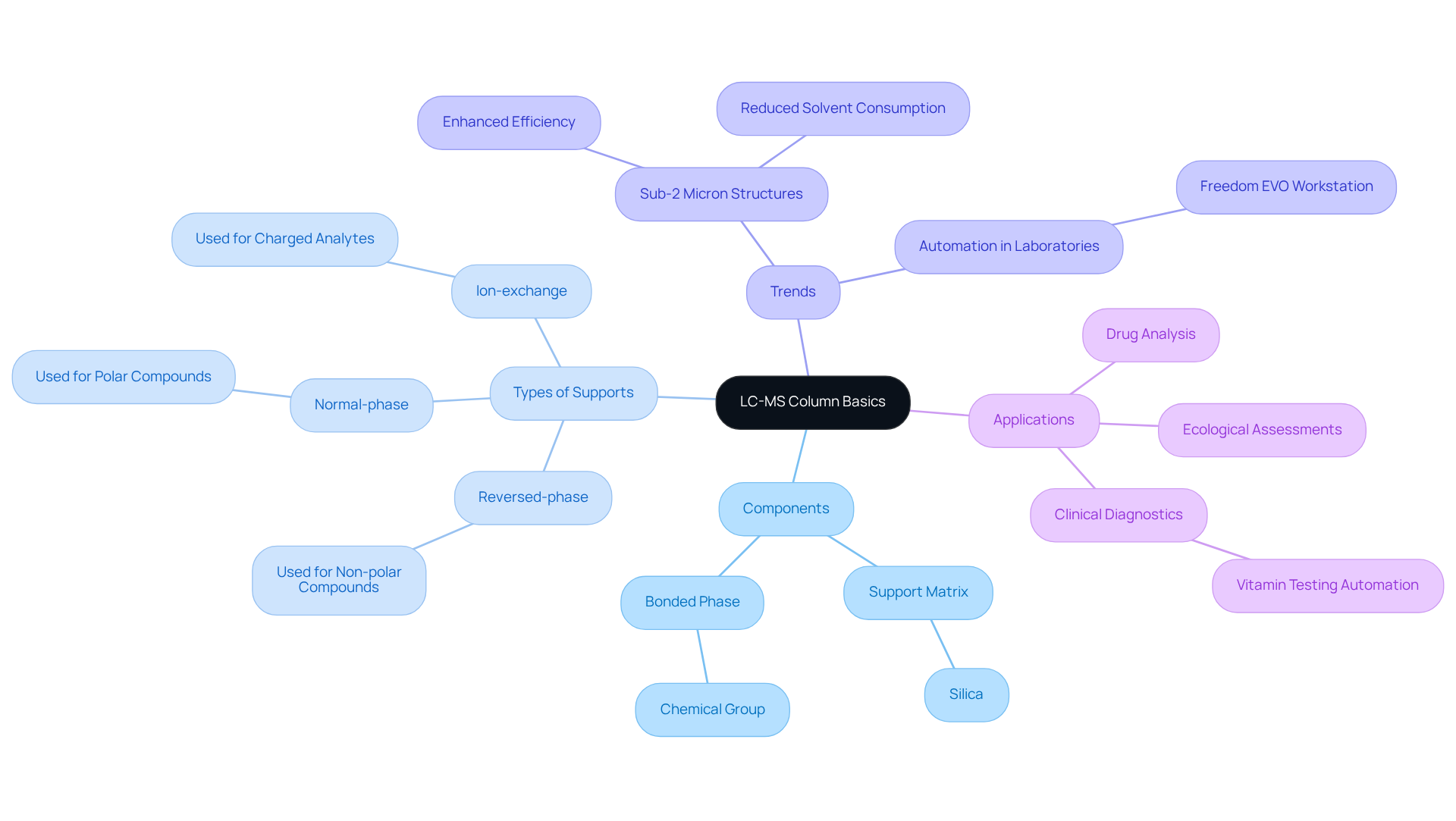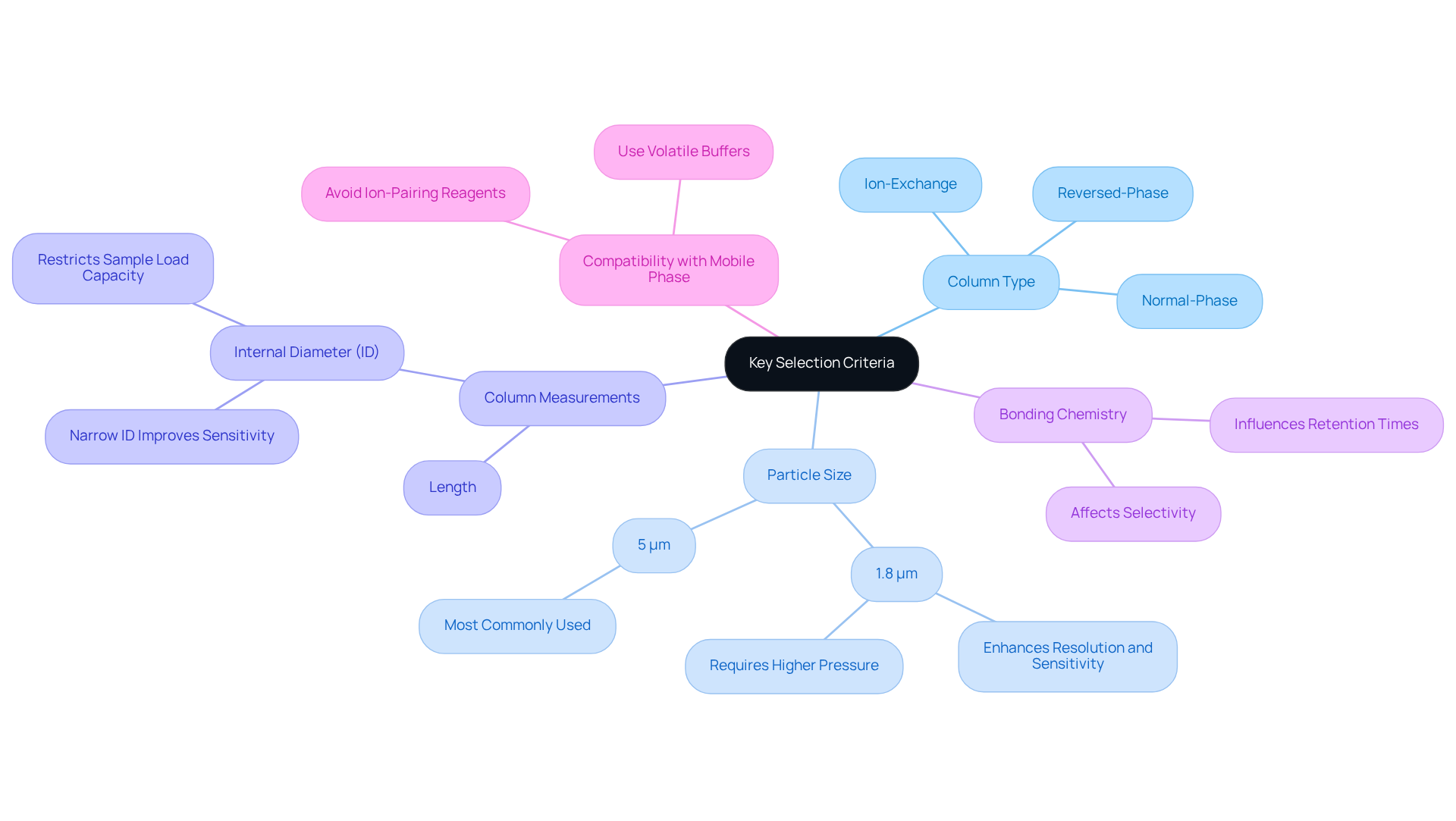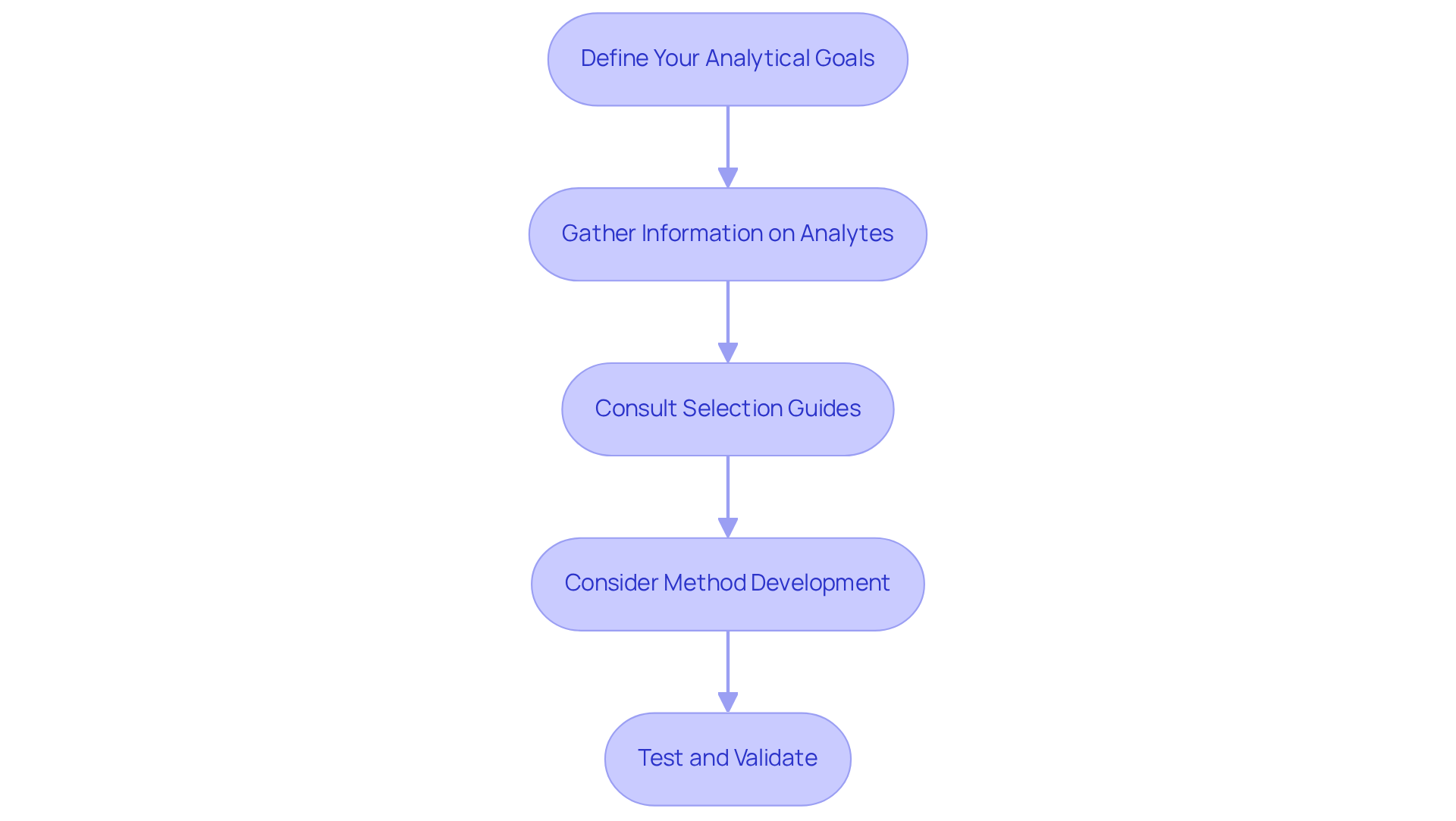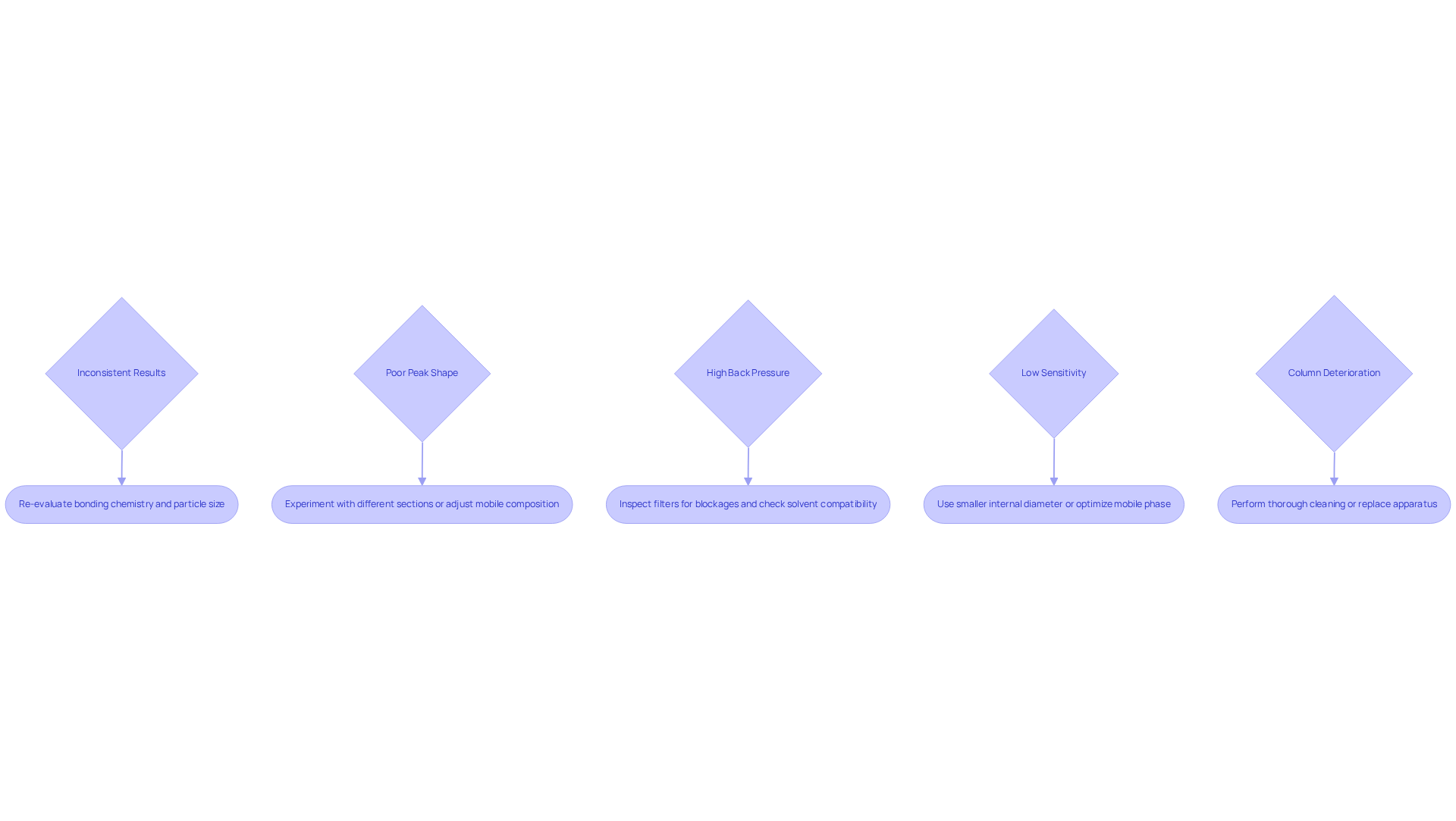Overview
The article presents a comprehensive overview of the step-by-step selection process for mastering LC-MS columns. It underscores critical criteria such as:
- Column type
- Particle size
- Compatibility with mobile phases
By detailing practical considerations and troubleshooting strategies, the article ensures that users are well-equipped to select the appropriate column for their specific analytical needs. This not only enhances laboratory efficiency but also bolsters reliability in results. Ultimately, the content serves as a vital resource for professionals seeking to optimize their analytical practices.
Introduction
Liquid Chromatography-Mass Spectrometry (LC-MS) serves as a cornerstone technique in analytical chemistry. However, the process of selecting the appropriate LC-MS column can often appear overwhelming. With an extensive array of options available, it is crucial to comprehend the intricacies of:
- Column types
- Particle sizes
- Bonding chemistries
This understanding is essential for achieving optimal results across various applications, from drug testing to environmental analysis. How can researchers confidently navigate this intricate selection process to ensure their analyses yield reliable and reproducible outcomes?
Understand LC-MS Column Basics
Liquid Chromatography-Mass Spectrometry (LC-MS) stands as a formidable analytical technique, merging the separation capabilities of liquid chromatography with the mass analysis functionalities of mass spectrometry. At the core of this process are chromatography structures, which consist of two primary components: the support matrix, typically made of silica, and the bonded phase, a chemical group attached to the silica. Understanding the available—reversed-phase, normal-phase, and ion-exchange—is crucial for selecting the appropriate one for your specific application. Each type possesses distinct properties that influence the separation of analytes based on their chemical characteristics.
- Reversed-phase materials are frequently employed in LC-MS columns due to their efficiency in separating non-polar compounds.
- Normal-phase materials excel in LC-MS columns with polar compounds.
- Conventional liquid chromatography devices generally range in length from 10 to 100 cm, a significant factor to consider when making your selection.
- The noteworthy trend towards sub-2 micron structures enhances efficiency and reduces solvent consumption, aligning with the industry's shift towards cost-effective solutions.
- As Dafydd Milton points out, many customers are opting for smaller containers filled with smaller particles, as they require less solvent.
- Furthermore, the significance of lot-to-lot and column-to-column reproducibility is paramount, ensuring consistent results in laboratory analyses.
The practical applications of LC-MS columns are vast, covering areas from drug analysis to ecological assessments. For instance, the automation of vitamin testing at Reinier de Graaf Hospital exemplifies how advanced LC-MS columns can enhance workflows and improve precision in clinical diagnostics. The versatility of the Freedom EVO workstation in managing various sample preparation procedures underscores the advancements in laboratory automation relevant to mass spectrometry applications. By familiarizing yourself with these essential concepts, you will be well-equipped to navigate the selection process for analytical columns, ensuring your laboratory achieves optimal results in its research endeavors.

Evaluate Key Selection Criteria
When selecting lc ms columns, several key criteria must be evaluated to ensure optimal performance in your analytical applications.
- Column Type: It is essential to choose from reversed-phase, normal-phase, or ion-exchange types based on the characteristics of your analytes. Reversed-phase materials are typically favored for their versatility across a range of applications.
- Particle Size: Smaller particle sizes, such as 1.8 µm, can significantly enhance resolution and sensitivity; however, they may necessitate higher pressure. While smaller particles can improve performance, it is noteworthy that the most in HPLC are 5 µm in diameter. Consider the trade-off between resolution and system pressure, which generally needs to exceed 400 bar for high-resolution applications.
- Column Measurements: The internal diameter (ID) and length of the column play crucial roles in influencing separation efficiency and analysis duration. A narrower ID can improve sensitivity but may restrict sample load capacity.
- Bonding Chemistry: Different bonding chemistries affect selectivity and retention times. Understanding the chemical interactions between the analyte and the stationary phase is vital for achieving desired results.
- Compatibility with Mobile Phase: It is imperative to ensure that the column material is compatible with the solvents and additives in your mobile phase to prevent degradation or contamination. Avoid using ion-pairing reagents that form complexes with ionic compounds unless volatile forms are utilized.
Moreover, appropriate maintenance and conditioning of HPLC tubes according to manufacturer specifications are crucial for prolonging their lifespan and achieving optimal outcomes.
By meticulously evaluating these criteria, you can effectively narrow down your options and select an lc ms column that aligns with your analytical needs.

Follow a Step-by-Step Selection Process
To select the appropriate LC-MS column, follow these essential steps:
- Define Your Analytical Goals: Begin by determining the specific objectives of your analysis, including the types of compounds you will analyze and the necessary sensitivity and resolution. As David S. Bell observes, "The majority of the entries in this category focus on contemporary particle bonding and hardware technology," underscoring the importance of aligning your objectives with the capabilities of available options.
- Gather Information on Analytes: Collect comprehensive data on the chemical properties of your analytes, such as polarity, molecular weight, and functional groups. This information is crucial for your type selection. For example, the Supel Carbon LC 2.7-μm Capillary Column, which is part of the lc ms columns, is designed to resolve challenging compounds without HILIC conditions, making it suitable for a variety of applications.
- Consult Selection Guides: Utilize resources like manufacturer guides and online tools to compare different types based on your criteria. Many manufacturers provide flowcharts or decision trees to streamline this process. The has seen significant innovation driven by demands for speed, reproducibility, and selectivity, reflecting the evolving landscape of chromatography.
- Consider Method Development: If you are developing a new technique, consider starting with a flexible type that can accommodate a range of analytes. Reversed-phase media often serve as an excellent foundation. For instance, the AdvanceBio Surfactant Profiling HPLC devices are specifically designed for examining non-ionic surfactants in biologic formulations, showcasing innovations tailored for distinct analytical needs.
- Test and Validate: After selecting a column, conduct preliminary tests to verify its performance with your specific samples. Monitor critical parameters such as retention time, peak shape, and resolution to ensure it meets your analytical requirements. As you refine your method, remember that the introduction of new stationary phases and hardware enhancements indicates a shift towards specialized solutions.
By following this structured approach and integrating insights from industry experts, you can confidently select lc ms columns that align with your research goals, ultimately enhancing the reliability and efficiency of your laboratory analyses.

Troubleshoot Common Selection Challenges
When selecting LC-MS columns, you may encounter several common challenges that require your attention. Here are effective troubleshooting strategies to consider:
- Inconsistent Results: Variability in outcomes can often be traced back to the suitability of the section for your analytes. It is essential to re-evaluate the bonding chemistry and particle size to confirm compatibility.
- Poor Peak Shape: Broad or tailing peaks may suggest issues with packing or the necessity for an alternative stationary material. Experimenting with different sections or adjusting the mobile composition can yield significant improvements.
- High Back Pressure: An increase in back pressure may signal obstructions or incompatibility with the mobile medium. It is advisable to inspect the vertical or inline filters for blockages and ensure that the solvents used are appropriate for the material of the structure.
- Low Sensitivity: A lack of sensitivity might necessitate a setup with a smaller internal diameter or optimization of the mobile phase to enhance analyte retention.
- Column Deterioration: Regular monitoring of your support structure is crucial. If degradation is suspected, a thorough cleaning should be performed, or replacement of the apparatus may be warranted if it has reached the end of its lifespan.
By understanding these challenges and implementing effective troubleshooting techniques, you can significantly improve your success in selecting and utilizing LC-MS columns.

Conclusion
Mastering the selection of LC-MS columns is paramount for achieving optimal results in analytical applications. This guide has elucidated the complexities of the LC-MS column selection process, highlighting the importance of understanding the fundamental components, types, and criteria essential for making informed decisions. By comprehending these concepts, researchers can significantly enhance the reliability and efficiency of their laboratory analyses.
Key arguments presented include the diverse array of column types available—reversed-phase, normal-phase, and ion-exchange—each meticulously tailored to specific analyte characteristics. Furthermore, the significance of particle size, bonding chemistry, and compatibility with the mobile phase is critical. The structured, step-by-step approach to selecting an LC-MS column ensures that analytical goals are met while addressing common challenges that may arise during the selection process.
In conclusion, the insights shared in this article not only serve as a roadmap for selecting the right LC-MS column but also underscore the broader implications of making informed choices in laboratory settings. By adopting best practices and troubleshooting strategies, researchers can adeptly navigate the complexities of LC-MS technology, ultimately advancing their analytical capabilities and contributing to the evolving landscape of scientific research.




